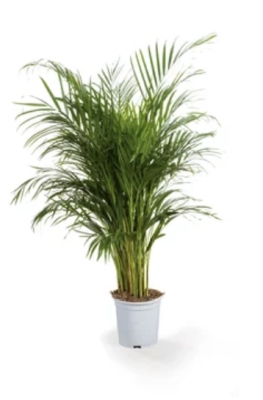Houseplants for Your Health
Blog Tag
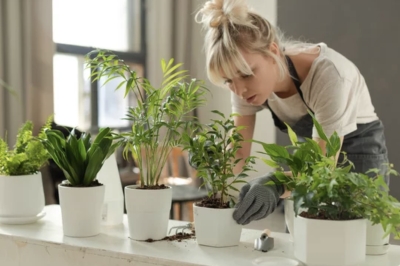 "Adopt the secret of nature: her secret is patience."
"Adopt the secret of nature: her secret is patience."
~ Ralph Waldo Emerson
To listen to my radio interview on This Week in America with host Ric Bratton on this topic of Houseplants for Your Health, with lots of personal stories and tips to develop your "green thumb," click HERE.
Scroll down to read about my favorite PLANT FERTILIZER that also supports whole-body healing & rejuvenation.
To learn more about creating a healthy, inspiring home environment, one that is peaceful, cozy, charming and timelessly elegant, please refer to my book UPLIFTED: 12 Minutes to More Joy, Faith, Peace, Kindness & Vitality.
Air Purification through Photosynthesis
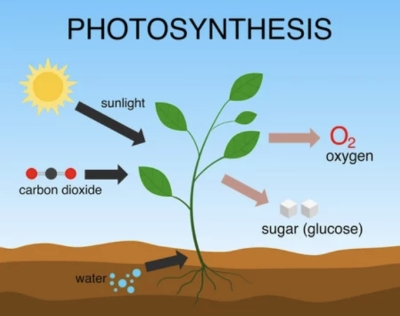 Plants are highly effective air purifiers due to their unique ability to absorb and filter harmful pollutants from the atmosphere. Through photosynthesis, plants take in carbon dioxide and release oxygen, naturally replenishing the air with fresh, breathable oxygen. Additionally, plants possess specialized structures called stomata that enable them to absorb various pollutants, such as volatile compounds (VOCs) and airborne toxins, effectively reducing their presence in the environment. NASA conducted a comprehensive study on plants as indoor air purifiers. Below you will learn about some of the best plants to enjoy in your living environment.
Plants are highly effective air purifiers due to their unique ability to absorb and filter harmful pollutants from the atmosphere. Through photosynthesis, plants take in carbon dioxide and release oxygen, naturally replenishing the air with fresh, breathable oxygen. Additionally, plants possess specialized structures called stomata that enable them to absorb various pollutants, such as volatile compounds (VOCs) and airborne toxins, effectively reducing their presence in the environment. NASA conducted a comprehensive study on plants as indoor air purifiers. Below you will learn about some of the best plants to enjoy in your living environment.
4 Suggestions for Houseplants
Everyone loves this luscious plant and you don't need a green thumb to grow it in your home or office. The Areca Palm is a natural humidifier that releases moisture into the air through transpiration. This can help combat dry indoor air, which can lead to respiratory discomfort and irritation. Their large, feathery fronds are also great at producing oxygen. Medium light.
2) Spider Plant
Spider plants are excellent air purifiers and are easy to care for. They remove pollutants like formaldehyde and xylene from the air, which are commonly found in household cleaning products and furniture. They also produce oxygen and help maintain humidity levels. Medium light.
3) Peace Lily
The peace lily is highly effective in removing airborne toxins like ammonia, benzene and formaldehyde. They also act as a natural air humidifier, increasing indoor humidity and reducing the risk of respiratory irritations. Low light.
4) Snake Plant Zeylanica
In NASA’s thorough investigation, they studied various plants’ ability to remove benzene from the environment. Snake plants scored extremely high, removing 52% of the toxic chemical in a 24-hour period. It’s also a great choice for bedrooms as it releases oxygen during the night. Low light.
A Medicinal Plant to Keep Year-Round in Your Home
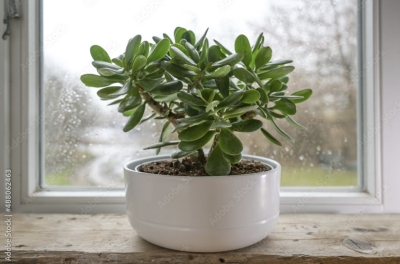 Not all plants are created equal, some have added medicinal properties. Aloe Vera is an easy wellness plant to grow in your home and harness its healing power. Just place it in your sunniest window, water it when the soil is completely dry and reap the rewards.
Not all plants are created equal, some have added medicinal properties. Aloe Vera is an easy wellness plant to grow in your home and harness its healing power. Just place it in your sunniest window, water it when the soil is completely dry and reap the rewards.
Medicinal Aloe: A succulent plant with fleshy leaves, aloe vera has been used for its medicinal properties for centuries. It contains a gel-like substance within its leaves that is rich in bio-active compounds, providing various health benefits. High light.
Ways Aloe Vera Benefits Our Health
1) Skin Health
 Aloe vera gel is renowned for its soothing and healing properties for the skin. It is commonly used to treat minor burns, sunburns and other skin irritations. The gel helps reduce inflammation, accelerates wound healing and moisturizes the skin without clogging pores.
Aloe vera gel is renowned for its soothing and healing properties for the skin. It is commonly used to treat minor burns, sunburns and other skin irritations. The gel helps reduce inflammation, accelerates wound healing and moisturizes the skin without clogging pores.
2) Digestive Health
Aloe vera juice, derived from the inner leaf gel, is known for its potential benefits on digestive health. It may help soothe gastrointestinal discomfort and alleviate symptoms of acid reflux.
3) Antioxidant Properties
Aloe vera contains antioxidants like vitamins C and E, as well as various flavonoids. These antioxidants help neutralize free radicals, protecting the body's cells from oxidative stress and potential damage.
The Connection between Plants and Reducing Stress
Stress Relief: Have you ever heard of the word Biophilia? Biophilia is the concept that human have an innate tendency to seek a connection with nature. Growing houseplants indoors allows us to bring a bit of the natural world into our living spaces, which can positively impact our mental state. Being around nature or natural elements has been linked to reduced stress, improved mood, and increased overall well-being.
Plants also have a consciousness and feelings and always appreciate your tender loving care and focused attention. If you breathe deeply while taking care of your plants and stay mindful, tuning into them, you will actually feel their positivity. To learn more about this, please refer to my book UPLIFTED. I often kiss and hug my plants indoors and outdoors and frequently hug trees. It keeps me youthful and happy.
Flowers Improve Emotional Well-Being
The mere presence of vibrant and colorful blooms can instantly uplift our spirits, brightening up any space and creating a sense of joy and happiness. The sight and fragrance of flowers trigger positive emotions, reducing stress and anxiety levels. Studies have shown that being surrounded by flowers can lead to increased feelings of relaxation and contentment. Lavender is a great example of a beautiful flower that supports relaxation, calmness and positive mental health.
 1) African Violet
1) African Violet
Enjoy the fuzzy foliage and adorable flowers of these indoor favorites. They will thrive in bright, warm and humid conditions. Keep water from touching their leaves or it will leave brown spots. Remove dead flowers and leaves as soon as you see them to encourage a healthier plant. Regularly check the soil for excess moisture, which will encourage rot. To get your violet to bloom constantly, fertilize once a month and place it in a high-light spot.
2) Orchids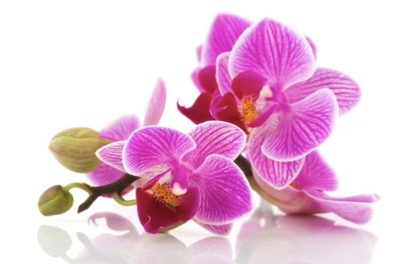 Bring joy to any room with the flowers of indoor orchids that can last from weeks to months. Choose from a wide variety of colors and varieties to suit your interior decor. Water when the roots are silver, place in a medium light level spot while the blooms are open and once they’ve faded in a few months, move your orchid to any sunny spot to promote new blooms.
Bring joy to any room with the flowers of indoor orchids that can last from weeks to months. Choose from a wide variety of colors and varieties to suit your interior decor. Water when the roots are silver, place in a medium light level spot while the blooms are open and once they’ve faded in a few months, move your orchid to any sunny spot to promote new blooms.
3) Anthurium
Not only do the colorful, glossy spathes add a pop of color to your interior, the heart-shaped leaves on this houseplant are incredible. Place in a warm spot and water when the top inch of soil has dried out. Fertilize frequently to enjoy repeat blooms. See the photo of this beautiful plant below to the right.
4) Kalanchoe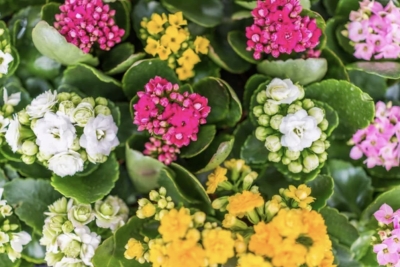 Adorable clusters of bright flowers atop succulent leaves will make you smile. Perfect for pairing with other indoor succulents or displaying in a matching pot. These prefer bright light and water when the soil has completely dried out.
Adorable clusters of bright flowers atop succulent leaves will make you smile. Perfect for pairing with other indoor succulents or displaying in a matching pot. These prefer bright light and water when the soil has completely dried out.
5) Hoya
These lovely houseplants are coveted for their fragrant and unique waxy flowers. Although it is not guaranteed to bloom — they’re worth the wait. Place your hoya in the sunniest spot in your home and water when the soil begins to dry out throughout the warm season. Don’t water your hoya over winter to encourage blooming.
Benefits of Lush Green Foliage
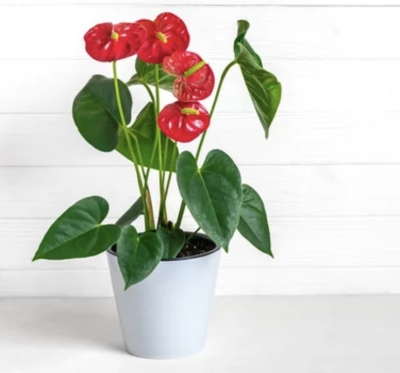 Greenery Boosts Cognitive Function: Lush green foliage in indoor spaces or natural environments has been associated with improved concentration, enhanced focus and heightened creativity. Studies have shown that exposure to green environments can help reduce mental fatigue and increase attention restoration, allowing individuals to better cope with cognitive challenges. The calming effect of greenery promotes stress reduction, which, in turn, supports clarity and problem-solving abilities.
Greenery Boosts Cognitive Function: Lush green foliage in indoor spaces or natural environments has been associated with improved concentration, enhanced focus and heightened creativity. Studies have shown that exposure to green environments can help reduce mental fatigue and increase attention restoration, allowing individuals to better cope with cognitive challenges. The calming effect of greenery promotes stress reduction, which, in turn, supports clarity and problem-solving abilities.
1) Money Tree
In Feng Shui, the Money Tree is believed to attract positive energy, wealth, and good luck. Place near entrances or office spaces to encourage prosperity. These easy care trees are tolerant of many indoor light levels but will be happiest if placed in a light-filled room and watered when the soil is dry.
2) Pothos
Glossy heart-shaped leaves, trailing vines and vigorous growth make this low maintenance houseplant a joy to own. Pothos are tolerant of many light situations but will grow best in bright spaces. Water when the top inch of soil is dry and trim regularly to promote bushy growth.
Caring for Plants Benefits Us... and the Best Tools
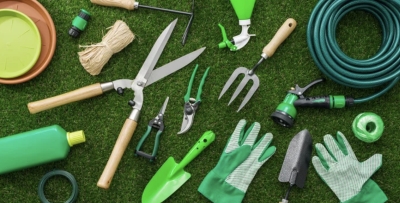 Mindfulness and Relaxation: Caring for plants can be a mindful activity, encouraging you to be present in the moment and focus on the task at hand. Engaging in such activities can help reduce anxiety and promote relaxation. Caring for the plants isn’t just about watering; you need a few tools.
Mindfulness and Relaxation: Caring for plants can be a mindful activity, encouraging you to be present in the moment and focus on the task at hand. Engaging in such activities can help reduce anxiety and promote relaxation. Caring for the plants isn’t just about watering; you need a few tools.
1) Snippers
Remove old or damaged leaves with a sharp, clean pair of snippers. These ergonomic and stylish "snips" are ideal for the delicate work of tending houseplants. Cleaning up your houseplants not only improves their aesthetic appeal, but encourages them to spend energy on producing new, beautiful foliage.
2) Fertilizer
Feeding your plants is easy - simply add some organic fertilizer to the soil of your plants and water thoroughly. Adding fertilizer into your routine means your plants will be happier, therefore, producing more flowers & foliage. See below on my favorite plant fertilizer.
3) Preserved Moss
Top dressing your plants not only adds style but also benefits your plants. In their natural habitat, plants usually don't grow in bare plots of soil - especially the tropical ones we tend to keep indoors! A layer of moss reduces surface evaporation and, in turn, reduces the frequency of your watering routine.
Aesthetic Approach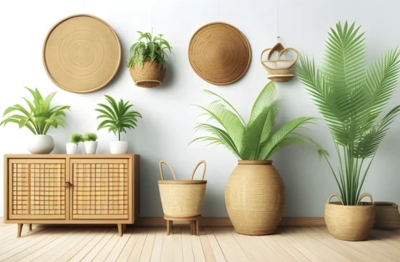 The presence of houseplants can improve the visual aesthetics of a space, making it more inviting and appealing. Surrounding yourself with aesthetically pleasing elements can positively impact your mood and help alleviate stress. Make looking at your plants even more enjoyable by styling them with pottery, basketry and home accessories.
The presence of houseplants can improve the visual aesthetics of a space, making it more inviting and appealing. Surrounding yourself with aesthetically pleasing elements can positively impact your mood and help alleviate stress. Make looking at your plants even more enjoyable by styling them with pottery, basketry and home accessories.
Landscape Design
Extend the benefits of plants outside with a bespoke landscape design. You can create a place to relax and appreciate nature with the help of your local nursery, who often offer free consultations. Whether you want a meditation space, a place for EARTHING (walking barefoot on the grass), a medicinal herb garden or a lush green landscape, work towards this goal.
Plant Fertilizer
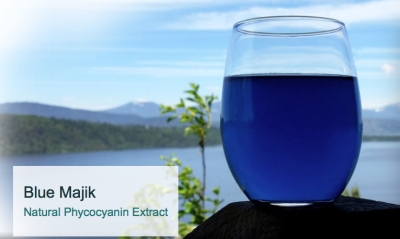 I have lots of plants in my home. While it's not in the company's literature, I discovered by accident many years ago that by putting 1/4 teaspoon of the Blue Majik powder in a quart of water, shake or stir it up, and then use this cyan-colored water to fertilize my houseplants, it turns them into award-winning beautiful plants. Everyone who sees them in my home, asks me about how I got such a green thumb. When I show my guests my secret, they are amazed at the simplicity and effectiveness. It richly blesses their life, too, when they start using this powder as a plant fertilizer.
I have lots of plants in my home. While it's not in the company's literature, I discovered by accident many years ago that by putting 1/4 teaspoon of the Blue Majik powder in a quart of water, shake or stir it up, and then use this cyan-colored water to fertilize my houseplants, it turns them into award-winning beautiful plants. Everyone who sees them in my home, asks me about how I got such a green thumb. When I show my guests my secret, they are amazed at the simplicity and effectiveness. It richly blesses their life, too, when they start using this powder as a plant fertilizer.
To this simple mixture above using Blue Majik and water, I also add in 1/8 teaspoon of E3 Total Body Blend to the fertilizing solution. (For over 15 years, I have also taken internally E3 Total Body Blend as one of my nutritional supplements along with Blue Majik. So daily, this superlative combination heals, detoxifies and rejuvenates my body and mind and then, only when needed for my plants, this same solution is my plant-fertilizing secret tip, too.)
So not only can you drink this salubrious superfood combo of Blue Majik and E3 Total Body Blend for your whole-body rejuvenation, you can also use it as a plant-loving fertilizer.
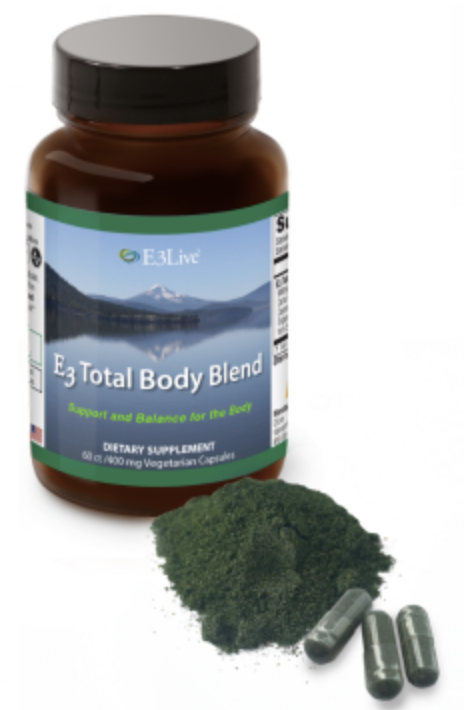 To learn more about Blue Majik or to purchase it now, click HERE.
To learn more about Blue Majik or to purchase it now, click HERE.
To learn more about E3 Total Body Blend or to purchase it now, click HERE.
To order by telephone, simply call: 888-800-7070 (US & Canada)
541-273-2212 (Intl), both PT, M - F • 8 - 5. Tell them hello from me (SSJ)!



